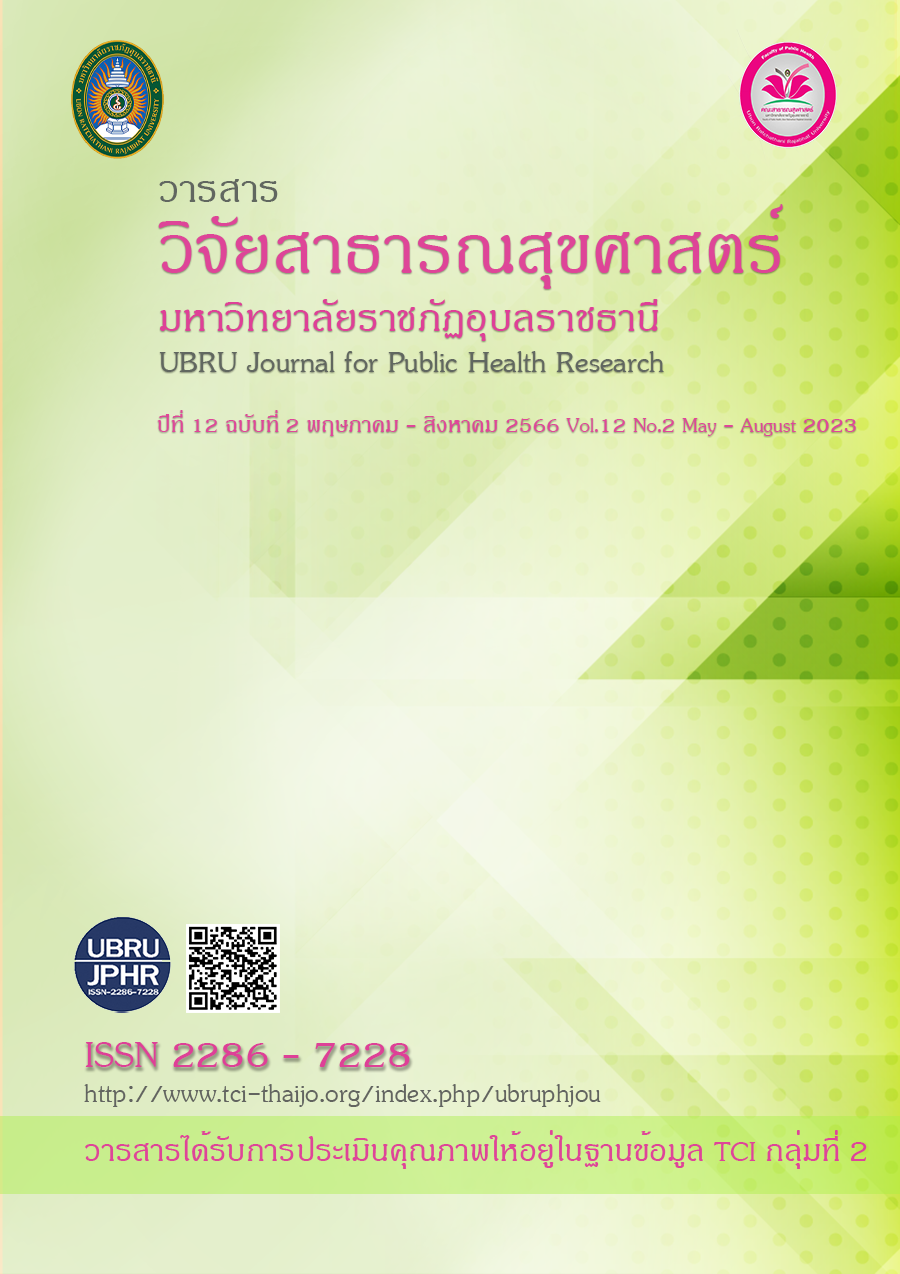การศึกษายาปฎิชีวนะตกค้างในผลิตภัณฑ์เนื้อหมูที่จำหน่ายในเขตกรุงเทพมหานคร
คำสำคัญ:
ยาปฎิชีวนะตกค้าง, ผลิตภัณฑ์เนื้อหมู, เนื้อหมูสด, ลูกชิ้นหมู, ยาปฎิชีวนะตกค้าง ผลิตภัณฑ์เนื้อหมู เนื้อหมูสด ลูกชิ้นหมู ไส้กรอกหมูบทคัดย่อ
ยาปฎิชีวนะถูกนำมาใช้ทั้งในมนุษย์ และในการปศุสัตว์ มีการใช้ยาปฎิชีวนะในการเลี้ยงหมูที่นำมาเป็นอาหารมนุษย์ การใช้ยาปฎิชีวนะอย่างไม่เหมาะสมส่งผลให้เกิดการตกค้างในเนื้อหมู และผลิตภัณฑ์เนื้อหมูแปรรูปที่นำมาบริโภค ผู้บริโภคได้รับยาปฎิชีวนะตกค้างจากการบริโภคเนื้อหมูและผลิตภัณฑ์จากเนื้อหมูอาจนำไปสู่ปัญหาเชื้อดื้อยา
การศึกษาครั้งนีมีวัตถุประสงค์เพื่อตรวจสอบยาปฎิชีวนะตกค้างในเนื้อหมู และผลิตภัณฑ์เนื้อหมูแปรรูป ทำการศึกษา 40 ตัวอย่างประกอบด้วยเนื้อหมูสด 26 ตัวอย่าง ลูกชิ้นหมู 6 ตัวอย่าง และไส้กรอกหมู 8 ตัวอย่าง ตรวจหายาปฎิชีวนะตกค้าง ด้วยชุดทดสอบยาปฎิชีนะ ตกค้างของกรมวิทยาศาสตร์การแพทย์ ชุดทดสอบนี้มีความถูกต้อง 93% ความไว 78.9% ความจำเพาะ 96.7%
ผลการศึกษาพบว่า จาก 40 ตัวอย่างตรวจพบยาปฎิชีวนะกลุ่ม Tetracycline ตกค้าง ร้อยละ 50.00 กลุ่ม Aminoglycoside, Macroline, Sulfonamide ตกค้างร้อย 37.50 กลุ่ม Penicillin ตกค้างร้อยละ 42.50. สำหรับตัวอย่างเนื้อหมูสด ตรวจพบยาปฎิชีวนะ กลุ่ม Tetracyclin ตกค้างร้อยละ 31.00 กลุ่ม Aminoglycoside, Macrolide, Sulfonamide ตกค้างร้อยละ 27.00 และกลุ่ม Penicillin ตกค้างร้อยละ 23.00 สำหรับตัวอย่างลูกชิ้นหมูตรวจพบยาปฎิชีวนะตกค้างกลุ่ม Tetracycline ตกค้างร้อยละ 83.00 3 กลุ่ม Aminoglycoside, Macrolide, Sulfonamide ตกค้างร้อยละ 50.00 และ กลุ่ม Penicillin ตกค้างร้อยละ 83.00 สำหรับตัวอย่างไส้กรอกหมูทั้งหมดตรวจพบยาปฎิชีวนะกลุ่ม Tetracycline ตกค้างร้อยละ 87.50 กลุ่ม Aminoglycoside, Macrolide, Sulfonamide ตกค้างร้อยละ 62.50 และ กลุ่ม Penicillin ตกค้างร้อยละ 75.00
สรุปได้ว่า ผลิตภัณฑ์จากหมูที่นำมาตรวจสอบพบยาปฎิชีวนะตกค้าง ร้อยละของยาปฎิชีวนะตกค้างพบในตัวอย่างเนื้อหมูสดน้อยกว่าเนื้อหมูแปรรูป เช่น ลูกชิ้นหมู และ ไส้กรอกหมู
เอกสารอ้างอิง
Adedeji W. (2016). The treasure called antibiotics. Annals of Ibadan Postgraduate Medicine.14(2), 56-57.
Asianmedic. (2023). Determination of Drug Residues in Meat. cite 15 January 2023. from: https://asianmedic.com/wp-content/uploads/2020/02/Determination-of-Drug-Residues-in-Meat.pdf
Center for Disease Control and Prevention. (2021). Understanding Antibiotic Resistance in Water: A One Health Approach. cite 15 January 2023. from: https://www.cdc.gov/onehealth/in-action/understanding-antibiotic-resistance-in-water.html
Granados-Chinchilla F. and Rodríguez C. (2017). Tetracyclines in Food and Feedingstuffs: From Regulation to Analytical Methods, Bacterial Resistance, and Environmental and Health Implications. Journal of Analytical Methods in Chemistry. 1315497
Information and Communication Technology Center. (2021). Data on the number of farmers, animal husbandry and livestock in 2021. cite 15 January 2023. from: https://opendata.nesdc.go.th/dataset/d7681470-0120-47ab-8315-5cd28b9539c8/resource/1b116b37-ce19-415d-ae04-dd734add184f/download/-2564.pdf
Maitreejit S., Patomkamtorn S., Srisanga S., Hinhumpatch P. (2021). The antibiotic residues in raw pork and beef sold at the fresh markets in Muang District, Phitsanulok Province. Journal of Public Health Naresuan University. 3(3): 16-28.
Makro. (2023). Butchery. cite 15 January 2023. from: https://www.makroclick.com/th/category/butchery/pork
Phonporton S., Pailee A.S., Wiriyaprasitchai W., Taechapornanan P. (2022). Determination of Antibiotic Residue in raw pork and chicken in markets in Bangkok, Nakhon Pathom and Nakorn Ratchasima provinces. Academic Journal of Community Public Health. 8(3), 35-44.
Pichameat. (2023). Pork cuts. cite 15 January 2023. from: https://www.pitchameat.com/
Pumkham J. (2012). Food is (not) safe... Effects of using antibiotics in animals. Thai food and drug Journal. 19 (3), 8-11.
Sooksai N, Ratbamroong N, Suwannaprom P, Chowwanapoonpohn H. Antibiotic Use in Livestock Farming: A Case Study in Chiang Mai. [Electronic version] Thai Journal of Pharmacy Practice. 8(2), 282-294.
World Health Organization. (2018). Global Action Plan on Antimicrobial Resistance - message from WHO Director-General. cite 15 January 2023. from: https://www.who.int/news/item/18-07-2018-countries-step-up-to-tackle-antimicrobial-resistance
ดาวน์โหลด
เผยแพร่แล้ว
รูปแบบการอ้างอิง
ฉบับ
ประเภทบทความ
สัญญาอนุญาต
ลิขสิทธิ์ (c) 2023 คณะสาธารณสุขศาสตร์ มหาวิทยาลัยราชภัฏอุบลราชธานี

อนุญาตภายใต้เงื่อนไข Creative Commons Attribution-NonCommercial-NoDerivatives 4.0 International License.
เนื้อหาและข้อมูลในบทความที่ลงตีพิมพ์ในวารสารวารสารวิจัยสาธารณสุขศาสตร์ มหาวิทยาลัยราชภัฏอุบลราชธานี ถือเป็นข้อคิดเห็นและความรับผิดชอบของผู้เขียนบทความโดยตรงซึ่งกองบรรณาธิการวารสาร ไม่จำเป็นต้องเห็นด้วย หรือร่วมรับผิดชอบใดๆ
บทความ ข้อมูล เนื้อหา รูปภาพ ฯลฯ ที่ได้รับการตีพิมพ์ในวารสารนี้ ถือเป็นลิขสิทธิ์ของวารสารฯ หากบุคคลหรือหน่วยงานใดต้องการนำทั้งหมดหรือส่วนหนึ่งส่วนใดไปเผยแพร่ต่อหรือเพื่อกระทำการใดๆ จะต้องได้รับอนุญาตเป็นลายลักอักษรณ์จากบรรณาธิการวารสารนี้ก่อนเท่านั้น


